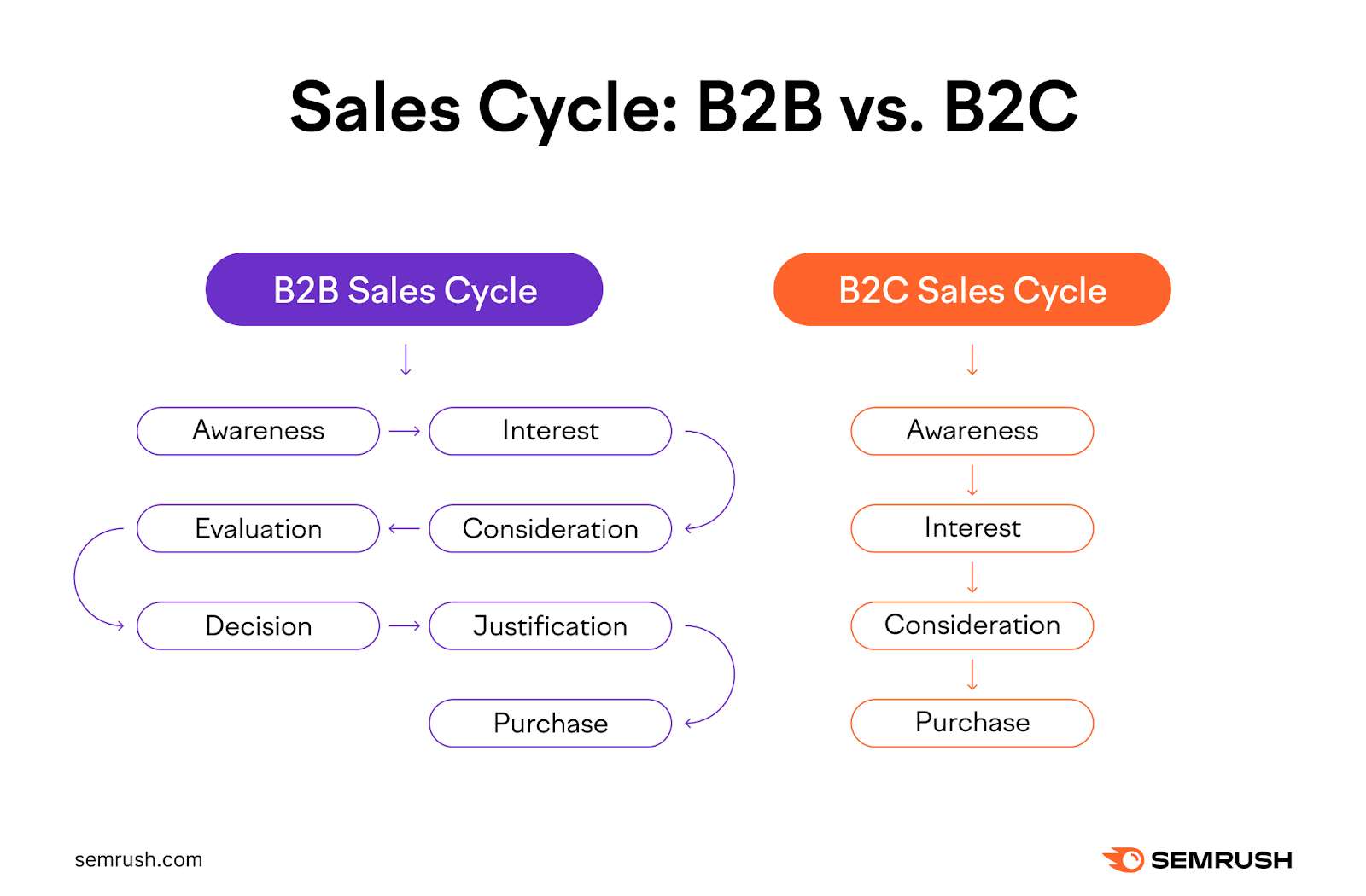
The business-to-business (B2B) landscape is evolving rapidly in response to digitalization, market trends, and technological advances. For example, the rise of ecommerce has enabled new business models, such as software as a service (SaaS) and dropshipping.
As the B2B market evolves, it becomes increasingly difficult to stay competitive. That’s why it’s essential to keep up with the latest industry trends, embrace digital transformation, and level up your technical skills.
Let’s discuss the best B2B marketing tactics to outperform your competitors in 2024.
What Is B2B Marketing?
B2B marketing is the process of promoting your products or services to other companies and organizations.
An example could be a software firm targeting small- and mid-sized enterprises. The software company may send out email newsletters, share product videos, and launch advertising campaigns to reach its audience.
Similarly, a copywriter who promotes their services to startups engages in B2B marketing.
How Does B2B Marketing Differ from B2C Marketing?
B2C marketing involves promoting your brand, products, or services to individuals.
Think about a company selling books or magazine subscriptions. Or a makeup artist promoting her services to brides.
The differences between B2B and B2C marketing lie in the target audiences and your strategies to reach them.
For example, the average B2B sales cycle is 2.1 months long. But in some cases, it can take up to 173 days or more. Most companies don’t buy B2B products or services immediately. The purchase must be approved by shareholders, managers, and other decision-makers.
The B2C sales cycle is much shorter. Consumers often make purchase decisions on the spot. Especially when buying essential items.
When selling to other companies, you must establish a rapport with decision-makers. Earn their trust and highlight the measurable returns your products or services can deliver.
From this perspective, B2B marketing often emphasizes relationship-building more than B2C marketing. Plus, it relies less on emotional appeal and more on hard facts.
Here are 20 B2B marketing strategies to gain a competitive edge and drive sales.
Leverage Account-Based Marketing for Personalized Engagement
Account-based marketing (ABM) identifies and nurtures high-value accounts or organizations. It creates personalized experiences for each account to drive customer engagement, loyalty, and sales.
In a 2022 survey, 72% of companies agreed that ABM delivers a higher return on investment (ROI) than other B2B marketing strategies and tactics. Also, 77% of respondents experienced revenue growth, and 84% increased their pipeline.
ABM programs focus on personalization. Here’s what that means.
Let’s say you’re a software development agency targeting large enterprises.
- A company’s chief financial officer may look into your product’s cost savings and efficiency gains
- The IT manager may want to hear more about the product’s technical specs, ease of integration, and compatibility with existing systems
- The operations manager will want to see how your product can help optimize inventory management, streamline workflows, or drive productivity
Given these aspects, it makes sense to personalize your B2B marketing efforts for each target account.
Create custom content and brand experiences, and engage with the key decision-makers at your target companies. Analyze the data collected from your campaigns to identify areas for improvement.
Data collaboration platform LiveRamp generated over $50 million from 15 high-value accounts. The company may have already been earning revenue from these accounts but saw increases after implementing ABM marketing.
LiveRamp made a list of Fortune 500 companies in its target market. It collected B2B data on each lead and chose 15 potential buyers based on specific criteria. Such as having at least 5,000 employees.
The company leveraged display advertising, email marketing, phone outreach, and direct mail to reach its target customers.
LiveRamp launched display ads to introduce its products to potential clients. It also used personalized direct mail and email marketing to educate, inform, and engage its audience.
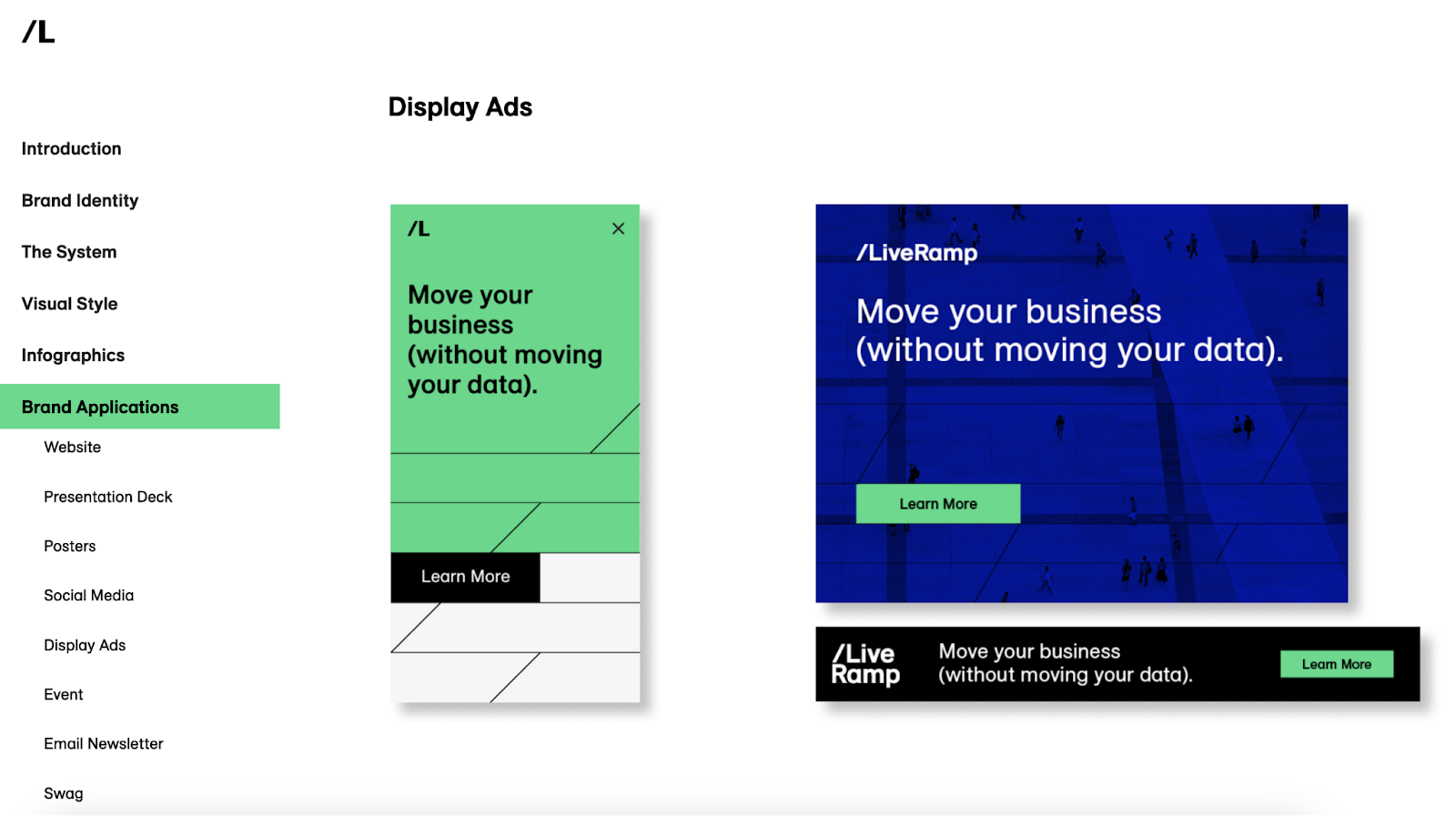
Lastly, its sales reps contacted those 15 clients by phone to address their concerns and provide more information about the platform.
Create a Data-Driven Content Strategy
A data-driven content strategy can make it easier to get your message across. Plus, you’ll provide more value to your target audience by crafting content that meets their needs. This can result in higher conversions, greater engagement, and increased trust.
Data-driven content also enables more effective ABM campaigns. For example, use your target accounts’ data to create personalized emails, ads, and other marketing materials.
Here’s how to get started.
Set Content Marketing Goals
Determine your content strategy goals. Is it brand awareness, increased sales, customer engagement, or lead generation?
Ensure every piece of content has a clear purpose and aligns with your overall marketing goals.
Define Your Key Performance Indicators (KPIs)
Next, assign specific KPIs to each objective to track your progress.
Say you want to measure the performance of a content marketing strategy aimed at driving brand awareness.
You could track website traffic, the number of unique visitors and page views, brand mentions, and social media engagement. Also, keep an eye on your email list growth rate.
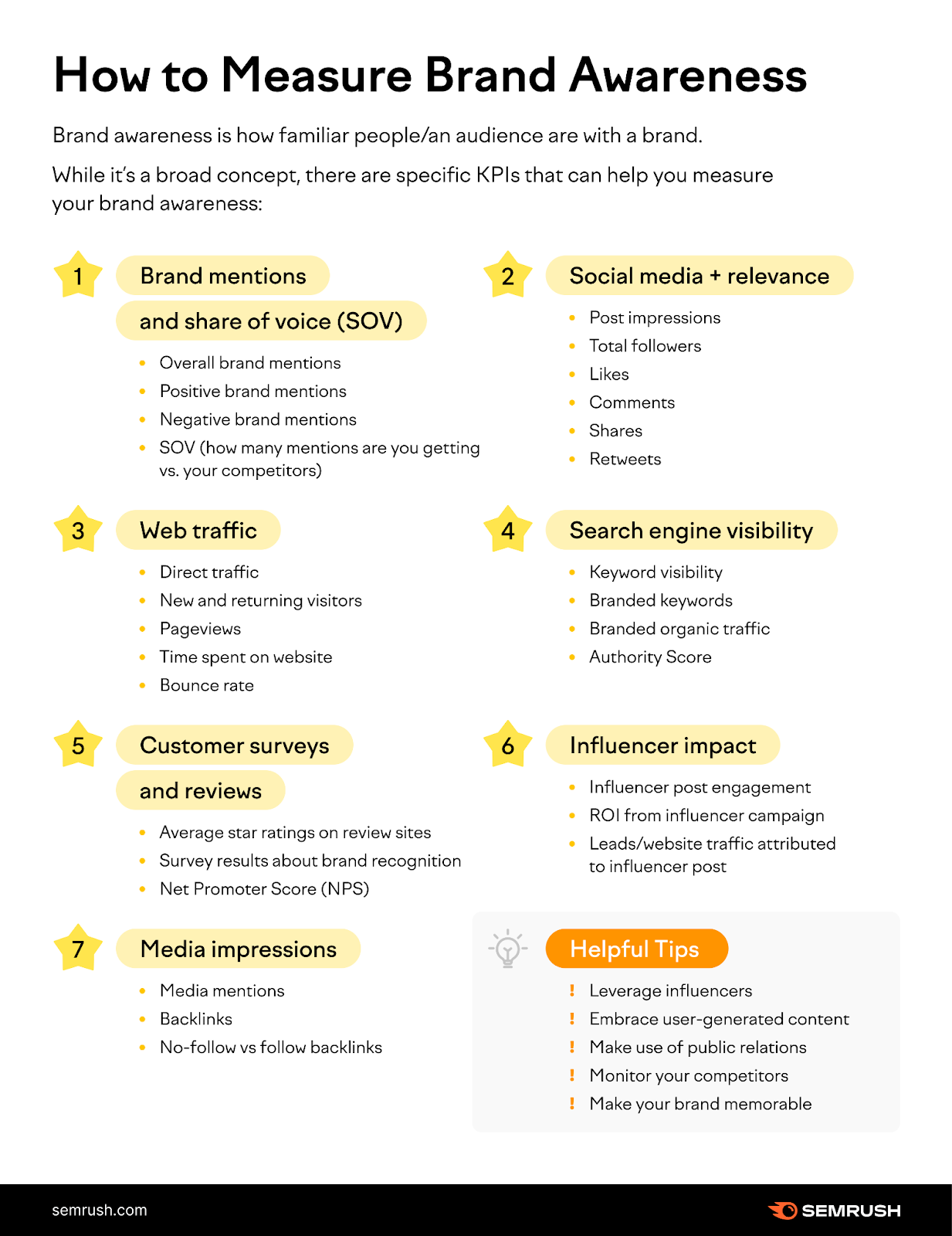
Further reading: How to Measure Brand Awareness—With Helpful KPIs
Analyze Your Target Audience
Collect data on your ideal customers to understand their needs and preferences. Consider their age, professional background, job title, annual income, and technical expertise.
Let’s assume you’re a PR agency targeting small businesses. A good strategy is to create content aimed at marketing managers.
Use tools like LinkedIn, Xing, and B2B databases to gain insights into your audience. Find out what type of content they create and share, what their interests are, and how their teams perform.
Leverage these insights to craft content that piques their interest and addresses their pain points. For example, a marketing manager interested in AI might want to watch a video showing how you use this technology to automate social listening.
Further reading: The Ultimate Guide to Content Marketing Strategy
Review Your Competitors’ Content
Check your competitors’ websites and social media pages to identify their top-performing content.
Say one of the competitors published a blog post about the most common leadership challenges. The article garnered hundreds of shares and likes on LinkedIn and other social media channels.
You could write a blog post on a similar topic from a different perspective. Or add additional insights, such as case studies and in-house research.
Measure Content Performance
Use Google Analytics, Google Search Console, or the Semrush Traffic Analytics tool to see what you did well and what you could improve.
With these tools, evaluate how your content performs over time. And which pages or blog posts generate the most traffic.
Leverage this data to refine your content strategy. For example, you could expand on high-performing topics or repurpose your most popular pieces into white papers, ebooks, or videos.
Further reading: Content Marketing ROI: How to Measure Your Success
Optimize Your Website for Search Engines
SEO is the process of optimizing your web pages for search engines. It involves keyword research, link building, content creation, and other tactics.
According to Sagefrog’s 2023 B2B Marketing Mix Report, 49% of B2B companies use SEO as part of their digital marketing strategy. And 34% of respondents said it’s their top lead source.
Since Google favors websites that provide a good user experience (UX), SEO can also make your site more appealing to visitors. As a result, they may spend more time reading your content and engaging with your brand.
A good starting point is to incorporate relevant keywords throughout your pages. Consumers use these search terms to find products, services, or information online.
Using the right keywords can make your content more discoverable in search results, leading to higher traffic and, possibly, increased sales.
Further reading: What Is SEO? Meaning, Examples & How to Optimize Your Site
How to Find Keywords for Your B2B Website
Semrush’s Keyword Magic Tool makes finding relevant keywords easier. Not only does it take the guesswork out of keyword research, it also provides actionable insights.
Let’s say you’re a small business consultant who wants to optimize a landing page featuring your services.
First, make a list of search terms relevant to your area of practice.
These could include “small business consultant services,” “small business consulting,” and so on. Use Google’s Autocomplete function for inspiration:
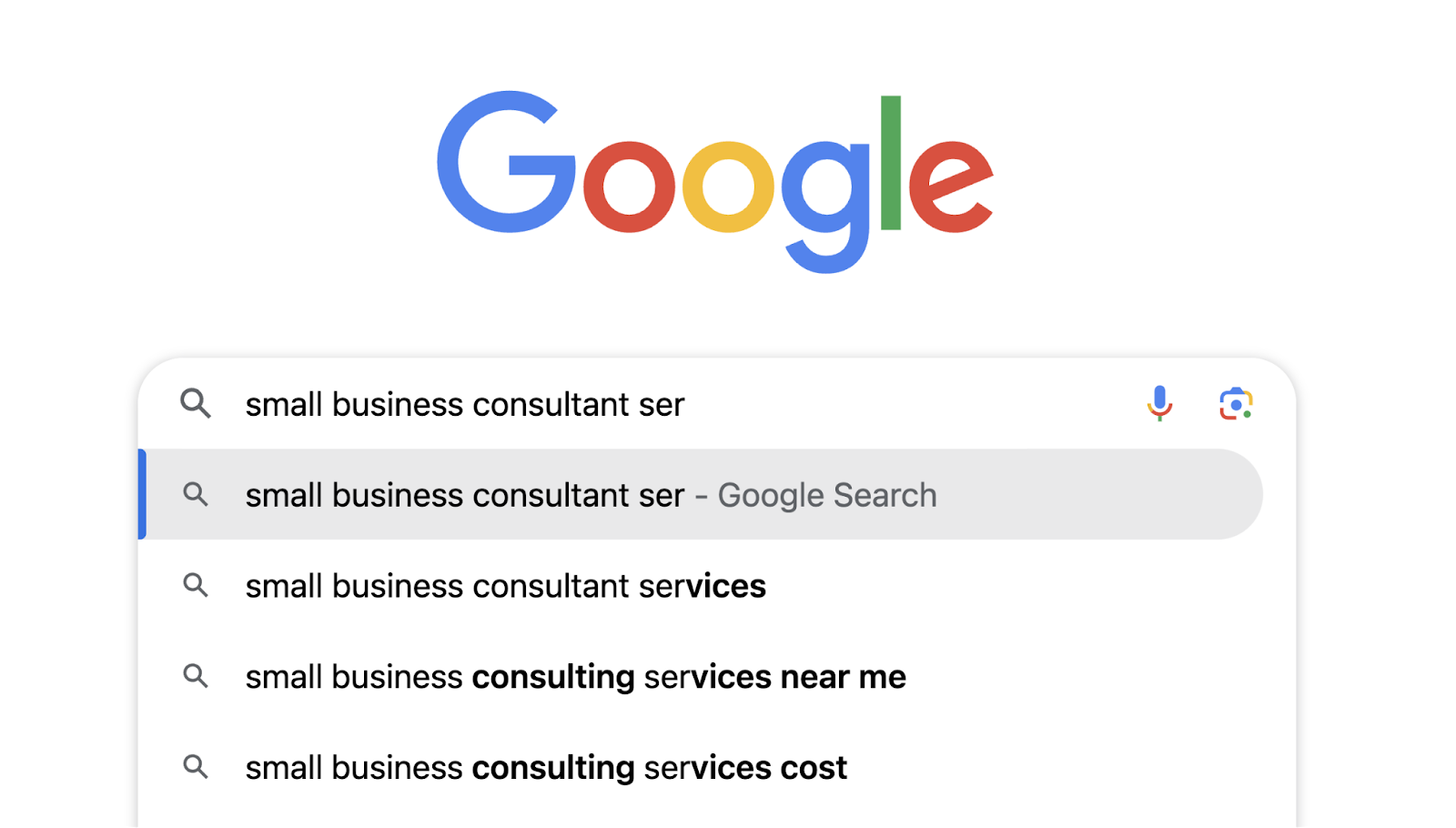
Now you have a list of “seed” keywords. These are the search terms you’ll base your research on.
Next, log in to your Semrush account or create one for free. Select the Keyword Magic Tool from the left-side navigation menu. You’ll find it under “Keyword Research.”
Enter one of your seed keywords into the search bar. Select your target market, such as the U.S., UK, or Australia, and click “Search.”

The Keyword Magic Tool will display a list of search terms related to your seed keyword. For each term, you can see its average monthly search volume over 12 months.
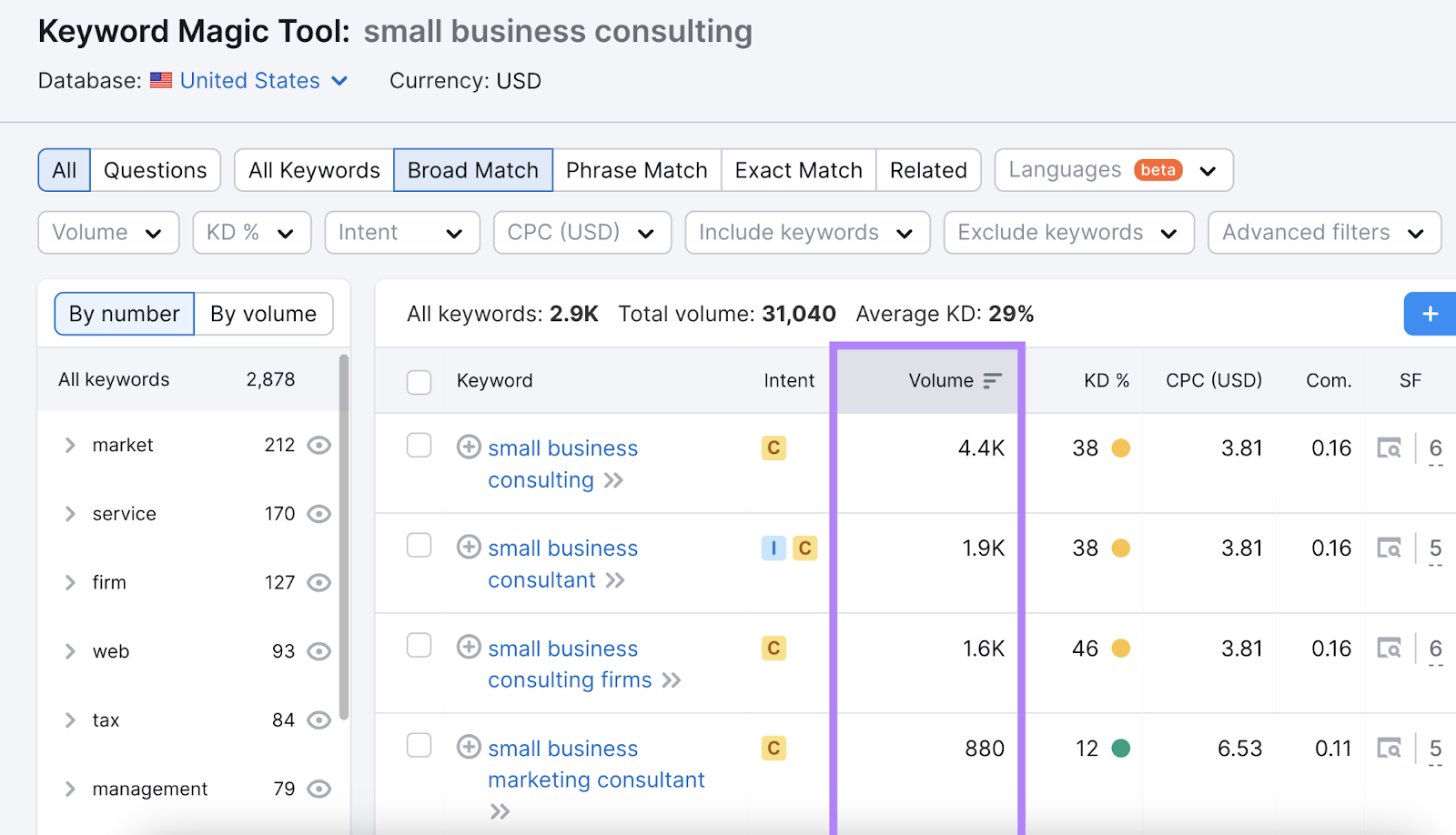
Our tool will also determine each keyword’s search intent, or user intent. This term describes the purpose behind a search query. There are four main types of search intent:
- Informational: The user searches for information on a topic.
- Example: What’s a good car?
- Navigational: The user searches for a specific website.
- Commercial: The user researches options for a product or service.
- Example: Subaru vs. Nissan
- Transactional: The user searches for a specific product or brand.
- Example: Buy Subaru Forester
Next, check the “Keyword difficulty” (KD%) tab to see how hard it may be to rank for a search term (on a scale of 0% to 100%).
Sort and filter the results by search volume, user intent, keyword difficulty, or other criteria, such as keyword length.
For best results, choose keywords with at least 100 monthly searches and a KD of up to 49%.
Select these options from the drop-down menu under each respective tab or enter the desired values in the “Custom Range” field under those tabs. Click “Apply.”
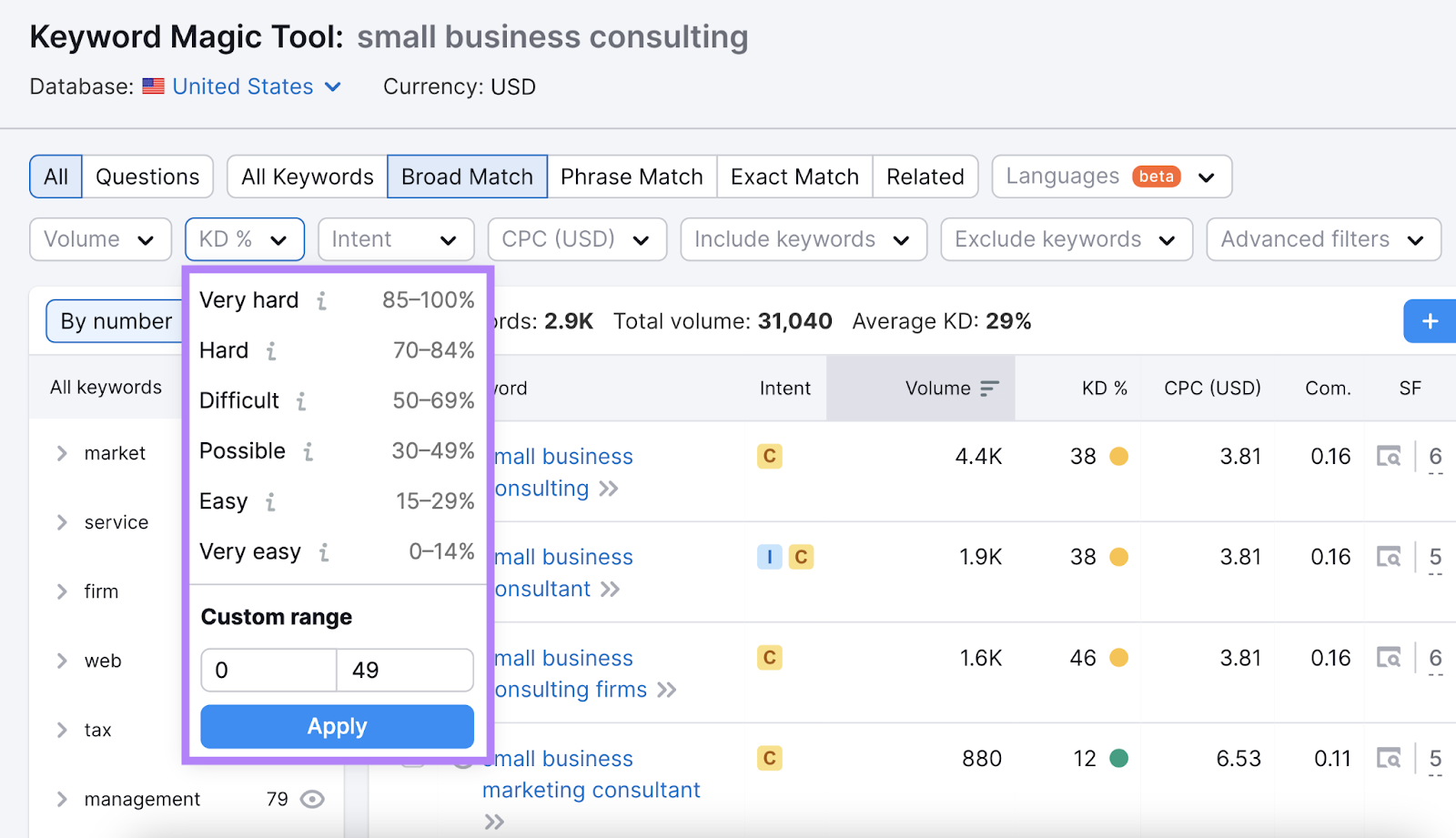
After applying these filters, you’ll have a list of keywords that match your requirements.
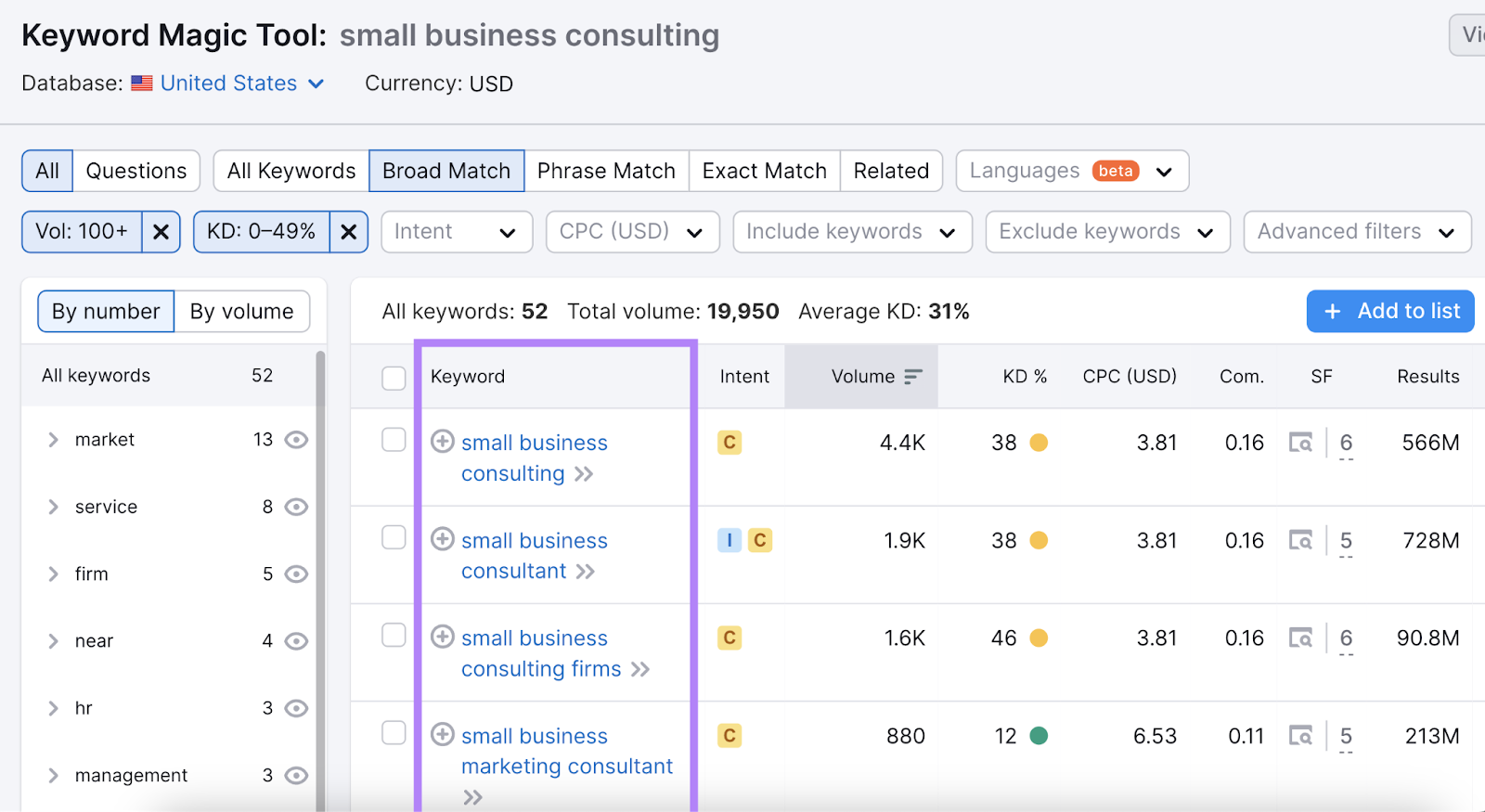
Go one step further, and sort the results by user intent.
For example, if you’re using your landing page to inform business buyers about your services, choose keywords with informational and/or commercial intent. Select these options from the drop-down menu under the “Intent” tab.
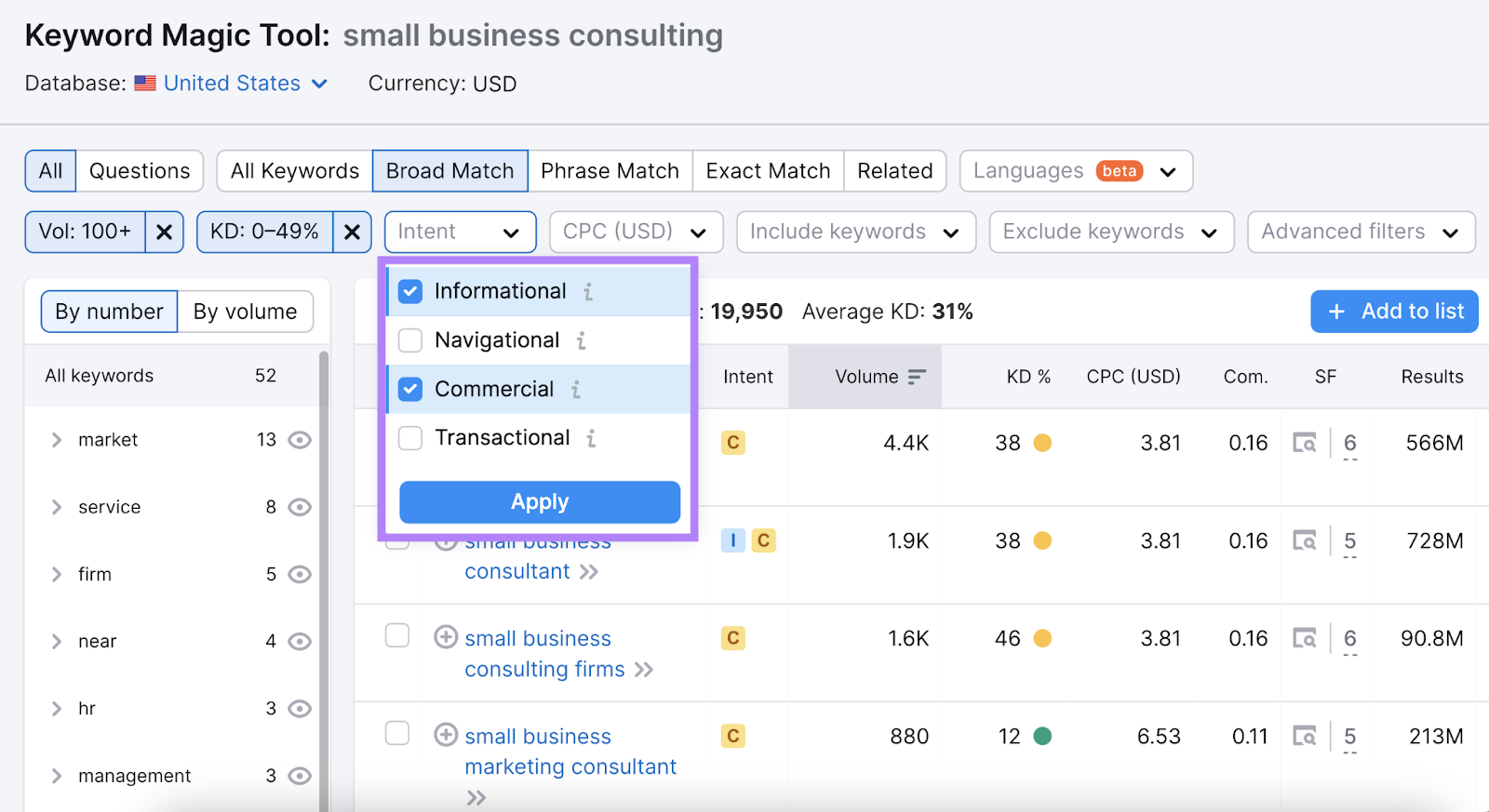
Now, select the most relevant keywords from this list, and use them throughout your content.
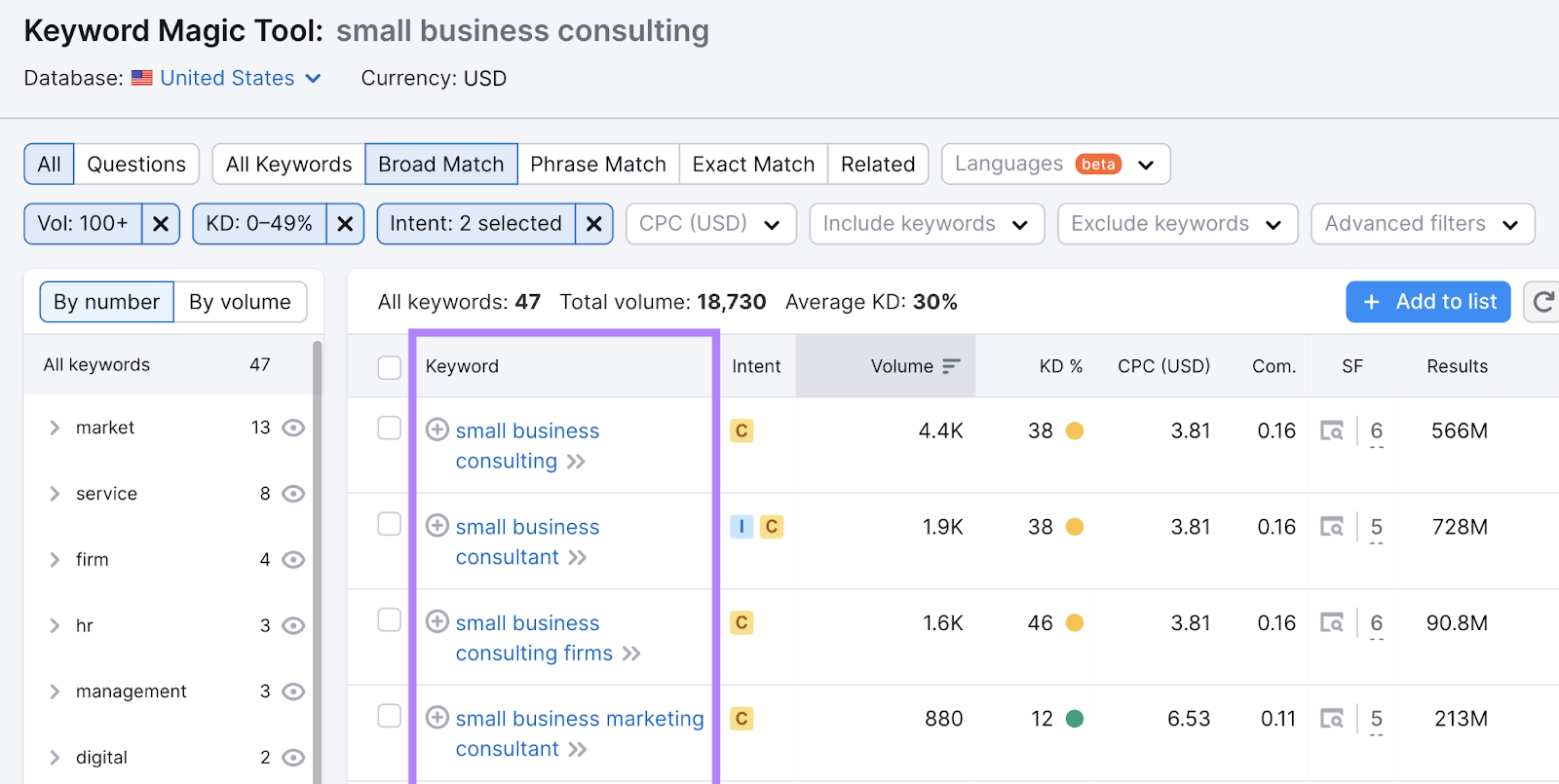
Optimize the page for one primary keyword, or main search term, such as “small business consulting.” Place it in strategic locations, like:
Also, use several secondary keywords (e.g., “small business consultant”) throughout your copy where appropriate. These search terms are related to your primary keyword.
Use LinkedIn for Lead Generation and Networking
More than 67 million companies use LinkedIn. Their goals may be to find talent, share information, or build meaningful relationships. The platform also has over one billion individual users, including entrepreneurs, CEOs, and industry leaders.
Leverage this professional network to identify and engage with prospective buyers. Build your online presence, reach a broad audience, and increase sales.
According to Sagefrog’s 2023 B2B Marketing Mix Report, networking is one of the top sources of sales and marketing leads.
As the world’s largest professional network, LinkedIn can generate exposure for your brand. This exposure can help you build trust and establish yourself as an authority in your field.
Let’s take a quick look at some of the best B2B marketing tactics for generating leads on LinkedIn:
- Add Featured sections to your profile page to showcase your work
- Share educational content on the LinkedIn Publishing Platform. Aim for a mix of short- and long-form content, such as case studies, slide shows, tutorials, success stories, and industry insights.
- Reinforce your unique selling proposition (USP) on your profile page and throughout your content
- Connect with industry leaders and potential B2B buyers. Engage with their content by leaving meaningful comments and sharing their posts.
- Join LinkedIn groups related to your business or industry. Share relevant content, engage in conversations, and answer other members’ questions.
- Personalize your outreach messages to prospective clients. Introduce your products or services as a potential solution to their challenges.
- Host webinars on LinkedIn to educate your target audience. This can be an opportunity to establish your expertise and build a community of followers.
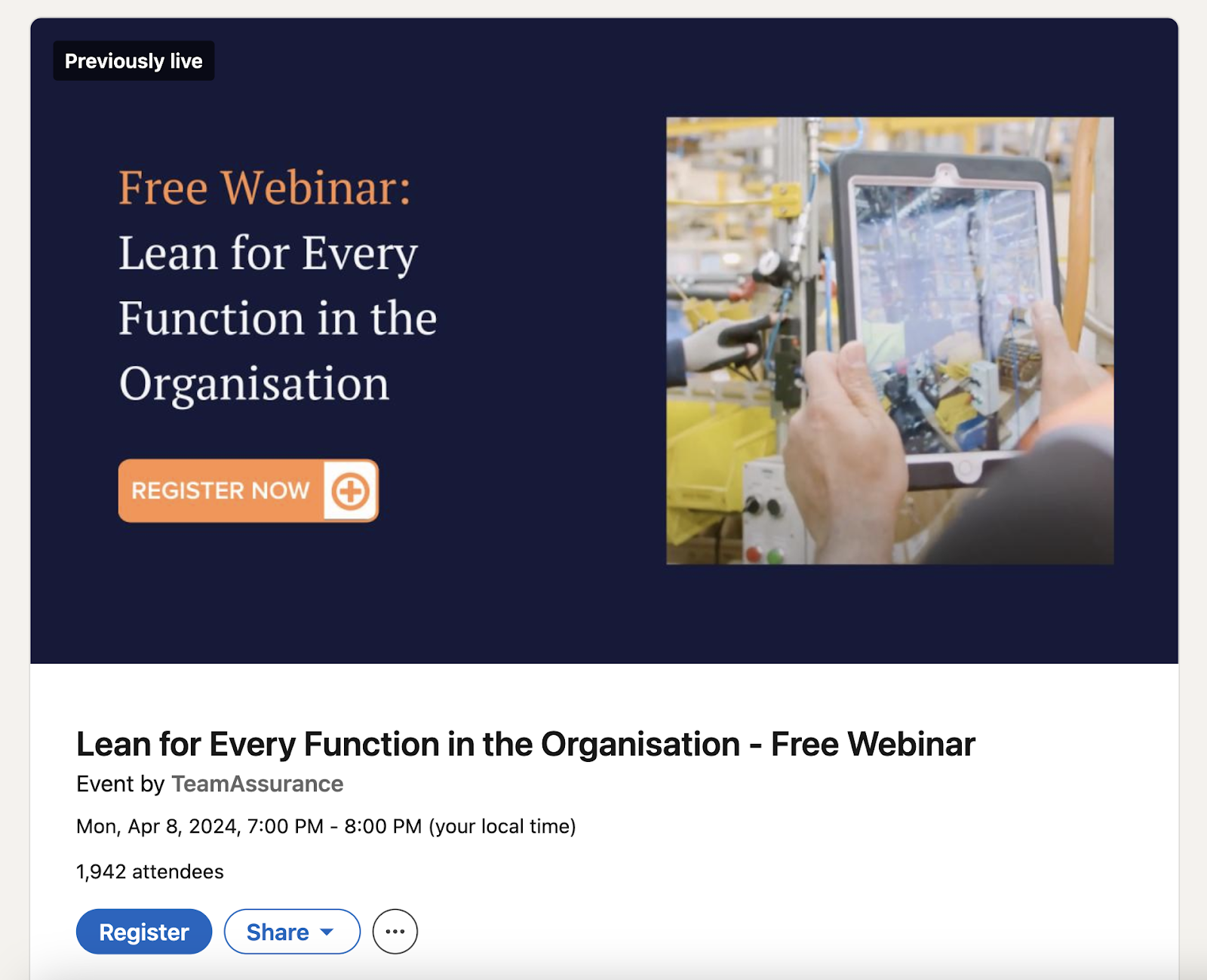
For further insights, see our complete guide to LinkedIn Marketing. We’ll show you how to build and engage your audience, what type of content to share, and how to track the results.
Automate Your Email Marketing Efforts
Email marketing was one of the top sources of sales and marketing leads for 22% of companies surveyed by Sagefrog.
This practice involves using email to attract, nurture, and convert prospects into buyers. You can also leverage email marketing to upsell or cross-sell products and engage your customer base.
For best results, use marketing automation software to send or schedule personalized emails.
Mailchimp, Campaign Monitor, Omnisend, and other email service providers have built-in automation tools. Send personalized emails at scale without manual intervention.
Set specific triggers to automate campaigns. For instance, you can send automated welcome emails to new subscribers, or re-engagement emails to customers who haven’t placed an order in six months.
Here’s an example from Copyfolio, an online portfolio builder for copywriters and other professionals:
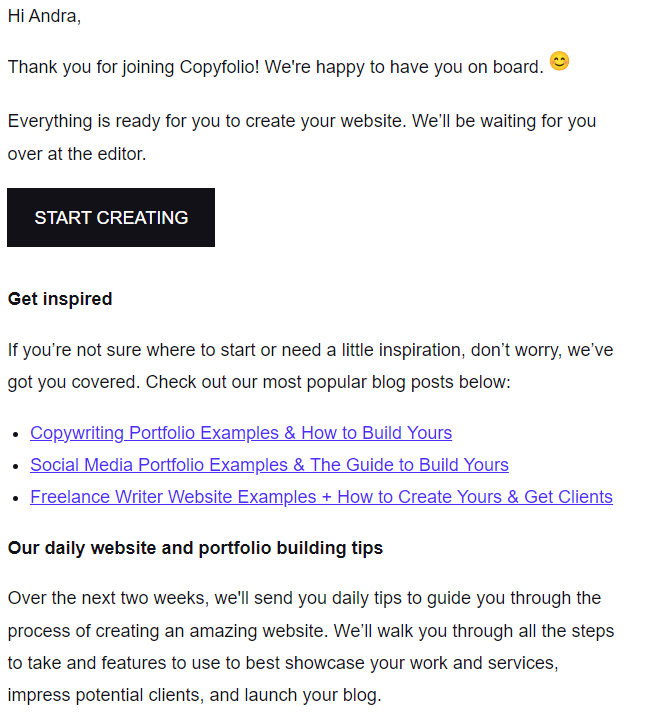
After joining the platform, you’ll receive an automated welcome email. It includes a call to action (CTA) button that says “Start Creating,” plus links to helpful resources for building your portfolio.
Registered users receive follow-up emails with additional tips and information every few days. See the example below:
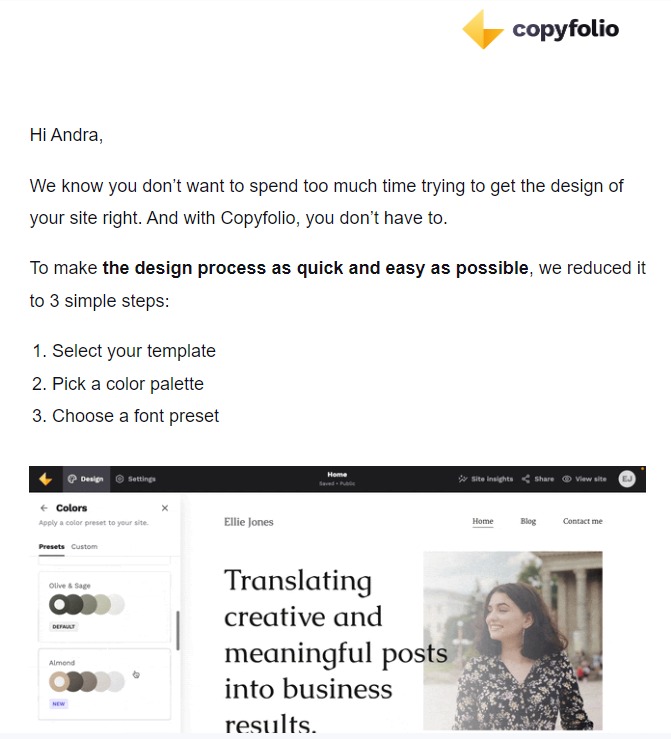
The company automates every message, which allows them to maintain consistent communication and save time.
Create Educational Webinars to Establish Thought Leadership
A webinar is a live video that enables participants to exchange information, ask questions, and interact in real time. Think of it as an online seminar or workshop.
Host webinars to educate your audience and establish thought leadership. Over time, you can build trust and generate qualified leads.
Let’s say you’re a financial advisor. Consider hosting webinars on relevant industry topics like tax planning, risk management, or enterprise insurance solutions.
Set aside 10-15 minutes for a Q&A session. Ideally, record the webinar and share it on your site or social media pages so visitors can watch it at their convenience.
For example, accounting and advisory firm Baker Tilly organized a series of webinars on tax planning. The videos are still available on the company’s website:
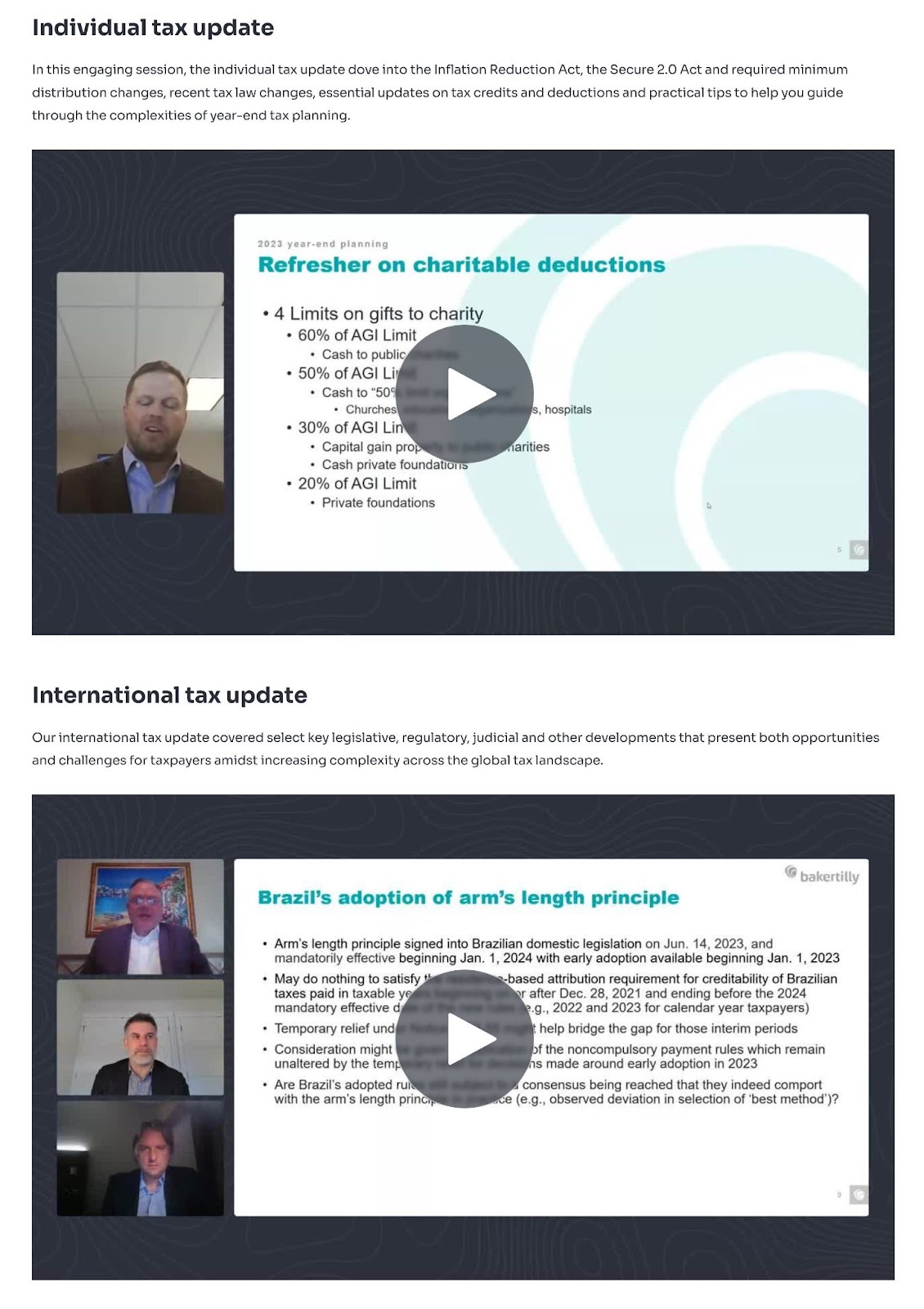
According to a 2022 report by the Content Marketing Institute (CMI), 51% of companies agree that webinars, webcasts, and web series outperformed other video formats over a 12-month period between 2020 and 2021.
And 14% of the respondents surveyed by Sagefrog rated virtual events, including webinars, as one of the top sources for generating leads.
Engage in Strategic Partnerships
Build strategic partnerships with non-competing businesses in your niche or industry. Reach a wider audience and discover new growth opportunities.
Let’s assume you’re a copywriter. Team up with a web design agency. Engage in cross-marketing activities, such as collaborative blog posts, joint webinars, or referral programs.
With this strategy, both parties provide more value to their potential customers and tap into each other’s audiences.
For example, Microsoft and the cybersecurity firm Check Point have worked together since the mid-1990s. The two companies promote each other’s products and services while offering enhanced value to customers.
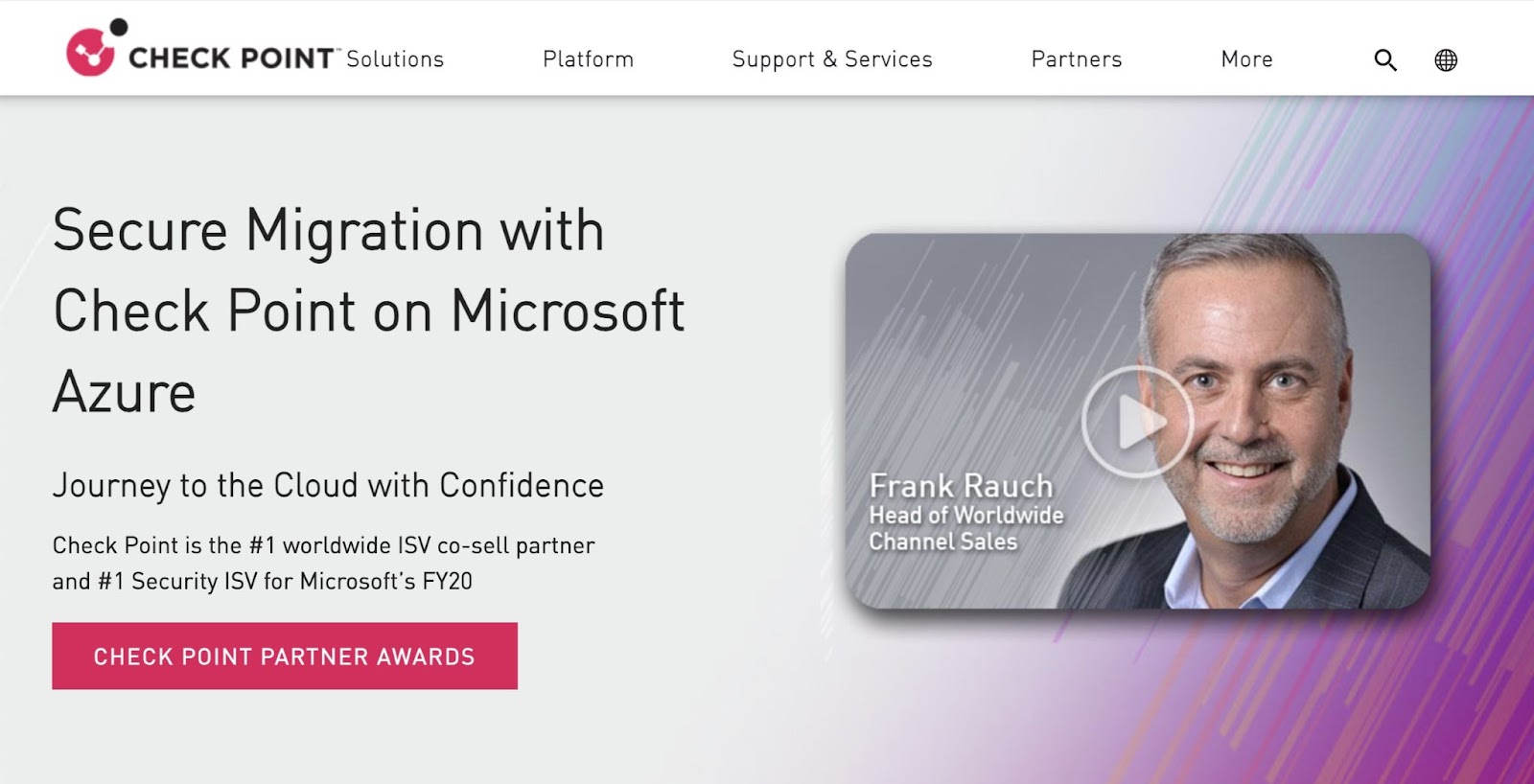
Further reading: How to Choose a Co-Marketing Partner: Experts Offer Tips
Invest in Video Marketing
Create and share videos related to your business and industry. Consider where your customers are in the marketing funnel and craft content that addresses their needs.
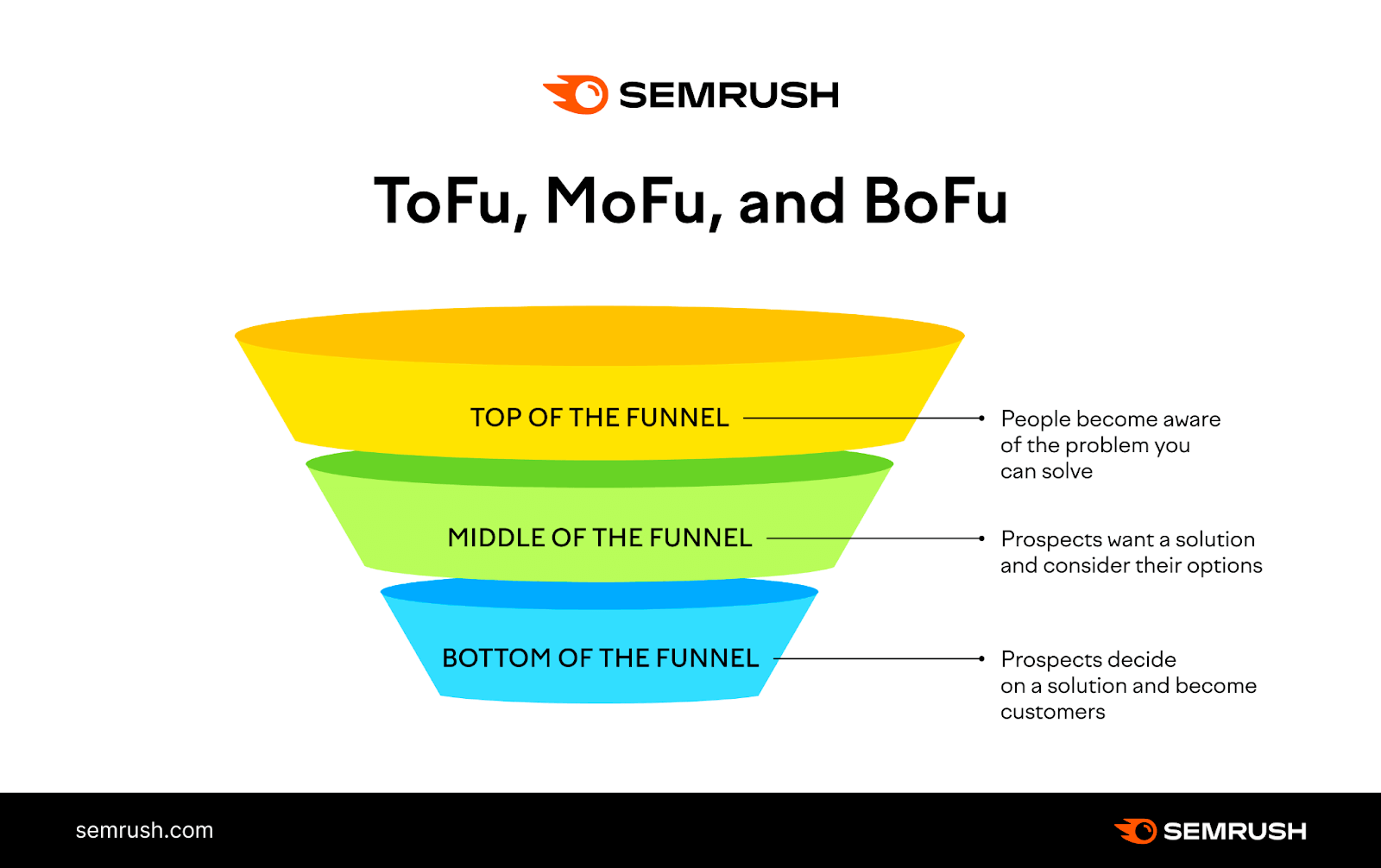
For example, potential B2B buyers who discover your brand may want to know more about it. At this stage (top of the funnel), consider sharing explainer, educational, and corporate/brand videos.
As the customer moves farther down the funnel, they’ll want to see how your offerings would benefit them.
To get their attention, share product, customer testimonial, case study, and demonstration videos.
This type of video works best for B2B customers who are already familiar with your products or services. They’re ready to buy, but need an extra push to take the final step.
In the 2022 survey conducted by the CMI, 38% of respondents said that videos produced the best results for their content marketing over a 12-month period between 2020 and 2021. This type of content outperformed podcasts, live streams, infographics, and articles over 3,000 words (e.g., ultimate guides).
Below is a case study video created by Semrush. It shows how an artisan bakery increased organic (unpaid) traffic 214% in just four months.

Create Interactive Content to Drive Engagement
Live videos, Q&A sessions, polls, quizzes, and other types of interactive content require user input. The audience can engage with the content by asking questions, sharing opinions, or chatting with a host in real time.
If, say, you launch a time management app, you can host a live Q&A session on Facebook or Zoom. Allow potential customers to learn more about your app and how it could benefit them.
Now, let’s assume you run a real estate business targeting corporate customers. Create virtual tours of the properties in your portfolio so potential buyers can explore office buildings, co-working spaces, and warehouses from their computers or smartphones.
Below is a virtual tour of an office building promoted by office space rental agency Ten Grand Street:

Viewers can “walk” through the building, measure the space, and see the floor plan from different angles.

Interactive content generates 52.6% more engagement than blog posts, news articles, and other types of static content.
From this perspective, it’s one of the most effective B2B inbound marketing tactics.
Enhance the Customer Experience with AI-Powered Chatbots
Use AI-powered chatbots to upsell or cross-sell products, guide customers through the buying process, and capture leads.
For instance, a sales chatbot can help website visitors determine which products meet their needs by:
- Initiating conversions (e.g., “Welcome to [store name]! What can we help with today?”)
- Making personalized product recommendations
- Scheduling bookings
All while collecting consumer data.
Below is an example from Volotea, a European airline. The company uses a chatbot to assist consumers with online check-ins, bookings, flight changes, and more.
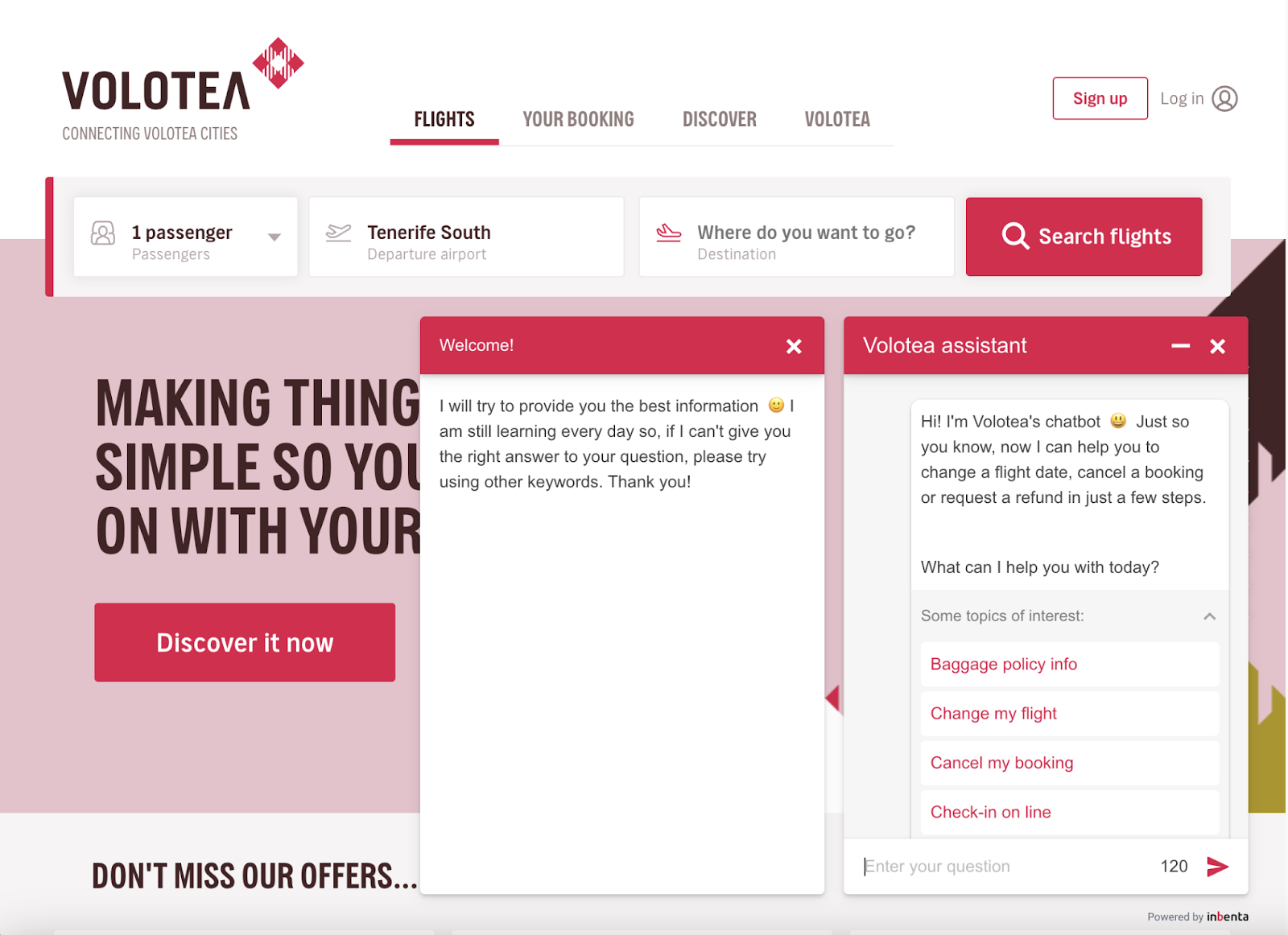
Per Statista research, 26% of B2B marketers using chatbots generated 10%-20% more leads in October 2022 thanks to this technology. Another 15% of respondents said chatbots helped them increase their leads by more than 30%.
Need one reason to implement a chatbot on your site?
This technology can free up your time. And enhance the user experience.
A chatbot would allow you to provide support around the clock. Resulting in shorter wait times and increased customer satisfaction.
Focus on Mobile Optimization to Reach B2B Decision-Makers
Mobile traffic accounted for 54.67% of all web traffic in the last quarter of 2023. And Google now takes into account the mobile versions of websites first as part of its ranking algorithm.
A website that looks good on any device can help you reach more buyers and improve their experience with your brand. It may also increase engagement and contribute to higher search engine rankings.
Here are some changes you can make for a seamless mobile experience:
- Simplify your forms by removing unnecessary fields
- Focus on improving page speed
- Switch to a responsive website theme to ensure it adapts to any screen size
- Remove unnecessary elements, such as pop-up windows
- Use hamburger menus or expandable menus for a clutter-free design
- Choose legible fonts like Open Sans, Poppins, Lato, or Roboto
- Break up your content with images, bullet points, sub-headings, and lists
- Add clickable contact buttons and large CTA buttons
For more tips and best practices, see our complete guide to mobile SEO.
Share Compelling Case Studies and Testimonials
Publish case studies, customer reviews, and testimonials on your site and social media pages to build trust. If possible, incorporate photos or videos from happy customers.
You can also include this content in email newsletters, sales pitches, white papers, and reports. Basically, any page designed to drive conversions.
Here’s an example from Venngage, an infographic design platform:
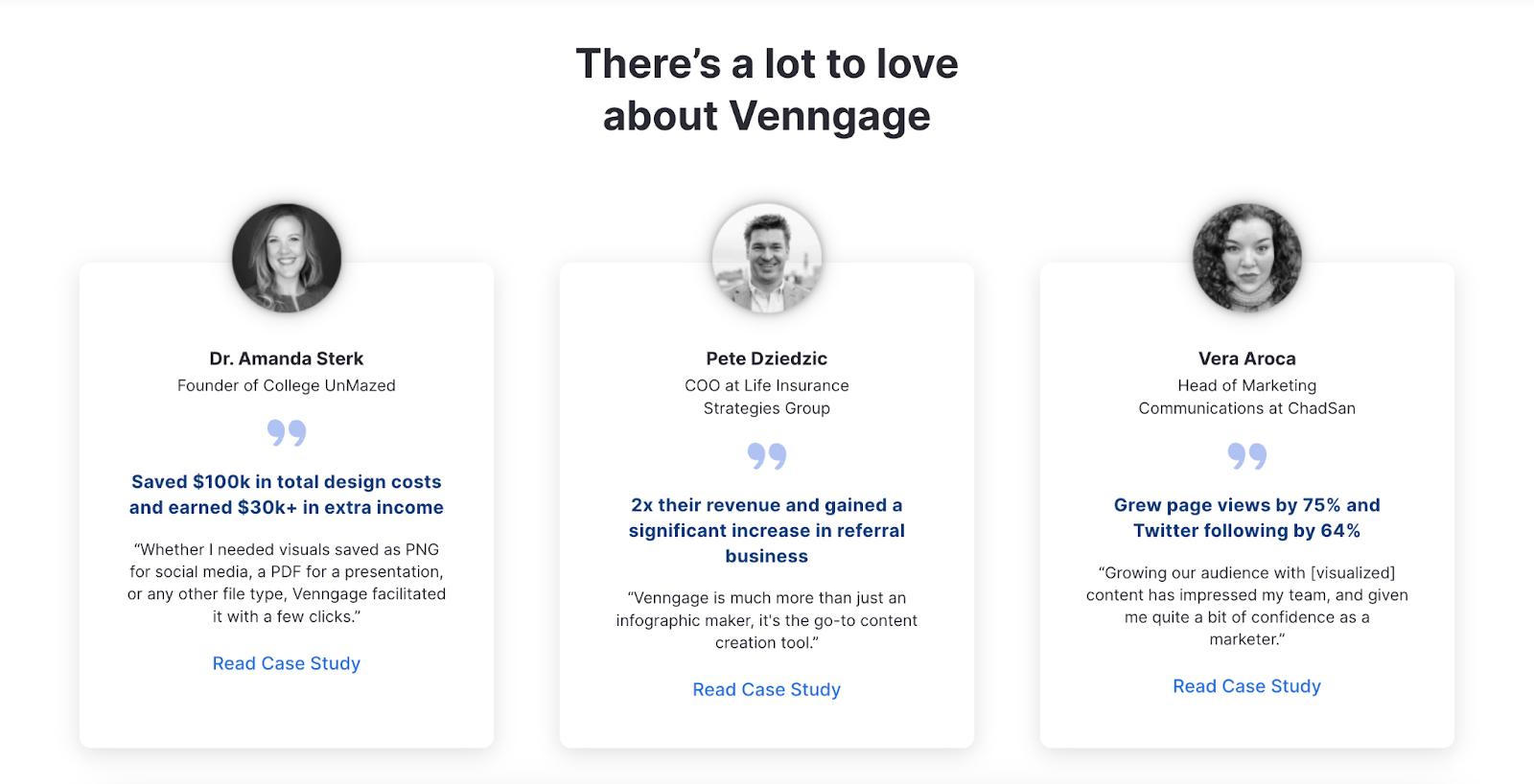
On its homepage, the company shared three case studies and customer reviews from trusted business professionals.
It also published another review from Peter Dziedzic, the President of Life Insurance Strategies Group, on its pricing page:
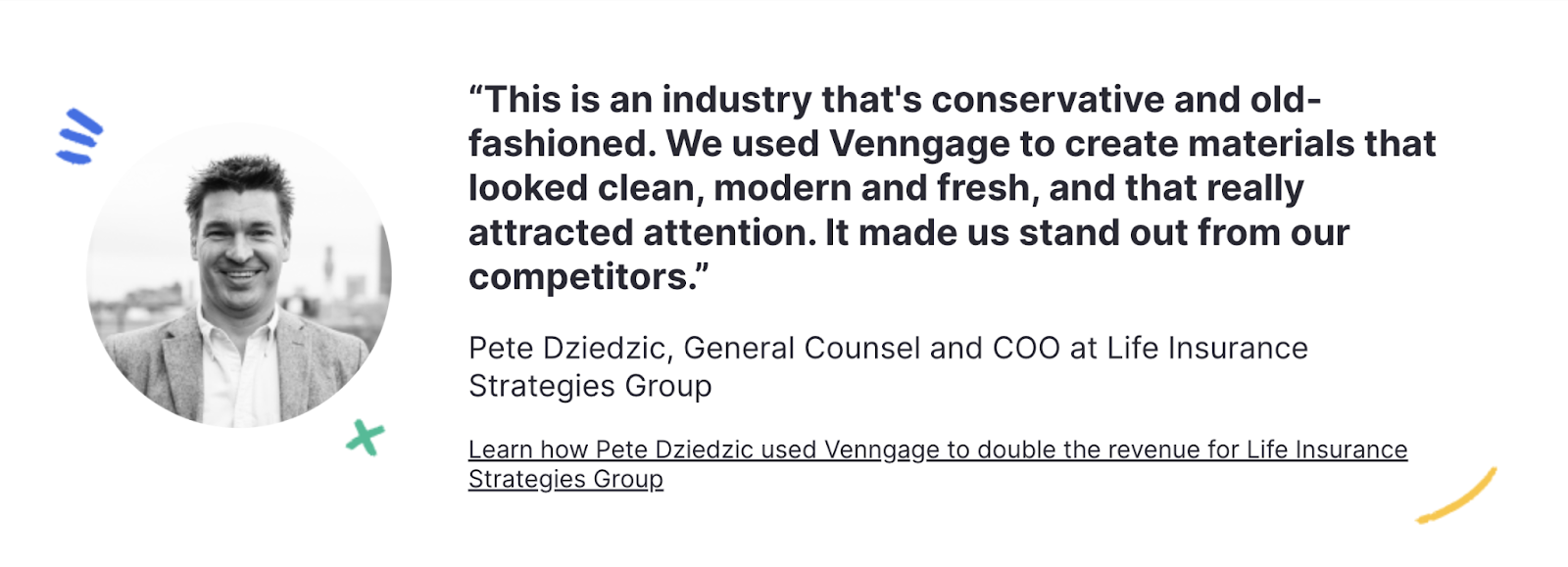
When a product or service has the approval of high-profile customers, its perceived value increases. Their endorsement can help build confidence in your brand, reassuring prospects they are making the right choice.
Not surprisingly, 39% of the companies surveyed by the CMI agreed that case studies produced the best results for their content marketing strategy over a 12-month period between 2020 and 2021.
Along with customer reviews and testimonials, this type of content serves as social proof, showing potential clients what you can do for them.
Further reading: How to Write a Case Study: Guide with Free Template + Examples
Social media advertising involves placing highly targeted ads on Facebook, LinkedIn, Instagram, and other social channels.
If executed properly, it can help you laser target your audience and generate quality B2B leads. It’s also a good way to raise brand awareness, gain visibility, and increase website traffic.
According to the CMI, 77% of marketing teams use social advertising and promoted posts.
The most popular choice was LinkedIn, followed by Facebook, Instagram, X (formerly known as Twitter), and YouTube. LinkedIn produced the best results, as reported by 79% of marketers. However, 54% of respondents got the best results with Facebook.
These findings suggest that what works for one business may not work for another. So, experiment with different platforms and ad types.
For example, carousel ads allow you to promote multiple products at once. Video ads, on the other hand, can be a great choice for quick product demos.
Below is a Facebook video ad featuring a Domestika online course:

It shows an example of the technique the linked course teaches, and a CTA button saying “Learn more” that will take the user to the advertised course.
Ready to launch your first campaign? First, check out this beginner’s guide to paid social media advertising.
Analyze Your Competitors to Gain Market Insights
Review your competitors’ websites and social media pages to see what they do well and what you could do better. Their advertising campaigns can provide valuable insights, too.
Semrush’s Traffic Analytics tool can help you delve into your competitors’ strategies.
If, say, you’re targeting the same audience as Freshbooks, you can use our tool to see its website traffic volume, top pages, conversion rates, and audience demographics.
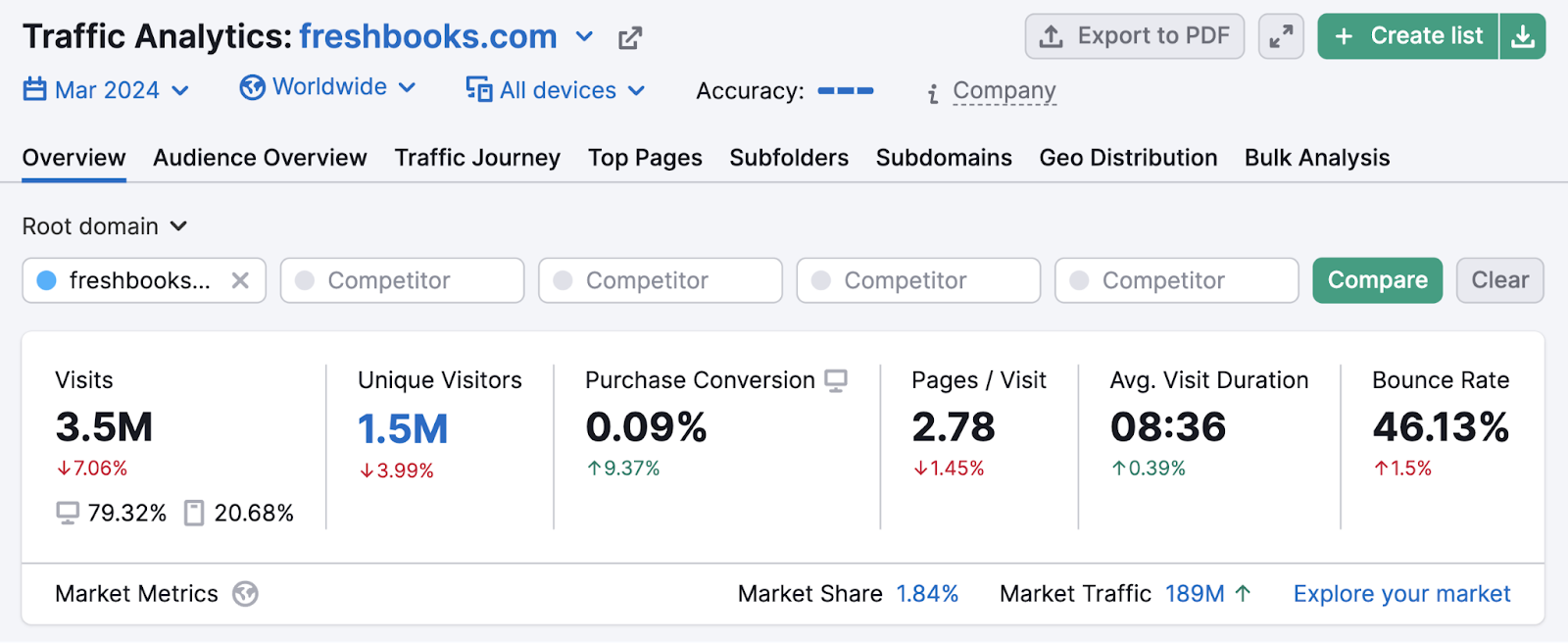
Leverage these insights to segment your audience, craft better content, and improve your SEO efforts.
For example, you could start promoting your content on the platforms that generate the most traffic for Freshbooks. Or you could enrich your customer data based on the information you glean from competitors.
Further reading: 8 Insights You Can Gain from Competitors’ Top Pages
Conduct Market Research to Make Data-Driven Decisions
Market research is an essential component of data-driven marketing. The more you know about your audience and industry, the more targeted your efforts. This can result in a better reach, time and cost savings, and improved resource allocation.
When it comes to B2B market research, you’ll need data on your competitors, prospective clients, and industry. Collect this data from internal or external sources.
Internal (primary) data comes directly from a company’s campaigns. For example, insights you gain from advertising will fall into this category.
Other sources of internal data may include:
- Website analytics
- Social media analytics
- Customer surveys
- A/B testing
- Focus groups
- Cash flow reports
External (secondary) data comes from third-party sources, such as:
- Government agencies
- Public or private B2B databases
- Peer-reviewed journals
- Online communities
- Market research reports
Collect accurate, relevant data from both internal and external sources to gain a complete picture of your target market.
For starters, follow the steps outlined in our market research guide. We discuss the best data collection methods, how to set goals for your research, and how to turn data into actionable insights.
Further reading: 11 Best Market Research Tools: Features & Pricing
Host Virtual Events to Delight and Engage Your Audience
Webinars are among the many virtual events that drive engagement. Your B2B marketing strategy may also include the following:
- Virtual trade shows
- Virtual conferences
- Online workshops and seminars
- Online festivals
- Product launches
- Virtual roadshows
- Virtual sales kickoffs
For example, the Shared Services & Outsourcing Network (SSON) hosted a virtual summit in February 2024. The event focused on AI and automation, featuring influential speakers from Siemens, Lexmark, Experian, and other global organizations.

If you’re on a budget, organize smaller-scale events featuring startup founders, niche influencers, or business partners. Leverage existing connections (e.g., your LinkedIn contacts), who may be more open to speaking at your event.
Highlight the opportunity to showcase their expertise and reach a new audience. Consider offering them an incentive, such as free products or a percentage of ticket sales.
In a 2023 survey, 39% of companies reported hosting virtual events to boost brand awareness. 26% of organizations said they use this approach to drive engagement, and 20% saw it as a way to generate leads.
Online events allow you to interact with prospects and customers in real time and see how they feel about your brand. Plus, you’ll nurture your audience by sharing educational content in an easily digestible format.
Implement Retargeting Campaigns to Increase Sales
Retargeting is the practice of launching paid advertising campaigns to attract prospects who have shown interest in your brand.
For example, you may target B2B customers who visited your site but didn’t make a purchase. Or you can launch an advertising campaign aimed at users who joined your email list without taking further action (e.g., booking a call).
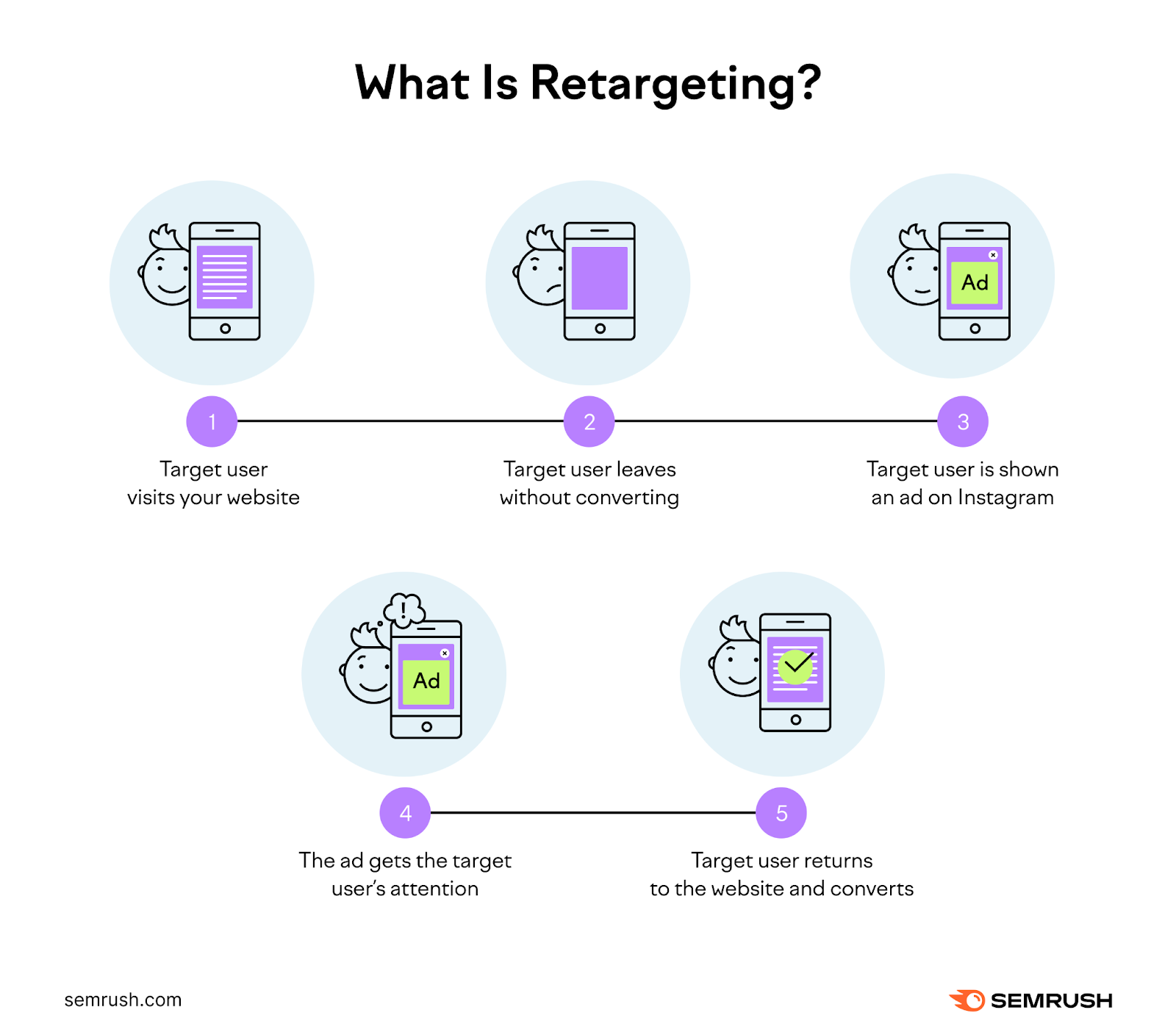
Retargeting allows you to reach out to customers already familiar with your products or services. They just need an extra push to move farther down the sales funnel.
A major advantage is that you can laser target your prospects based on their previous actions.
If, say, someone previously downloaded an ebook about search engine marketing (SEM), launch a series of ads focusing on this topic.
When that person clicks on your ad, it will take them to a landing page on your site. They can read more about a specific product or service (e.g., SEM consulting) that meets their needs, which could result in a sale.
Further reading: What Is Retargeting and How Does It Work?
Maintain Brand Consistency Across All Channels
An inconsistent brand image across multiple channels, including your website, social media pages, and online ads might confuse customers.
While adapting your marketing tactics to each channel and platform is important, your core message should remain the same. Consistency reinforces brand recognition and builds credibility.
Create a brand style guide highlighting your company’s mission, values, messaging, and voice. Ask your team members to stick to it, whether they’re launching an email campaign or writing blog posts.
For instance, Wells Fargo maintains a consistent brand image across all platforms. You can recall and recognize the brand as soon as you see its website and social media pages.
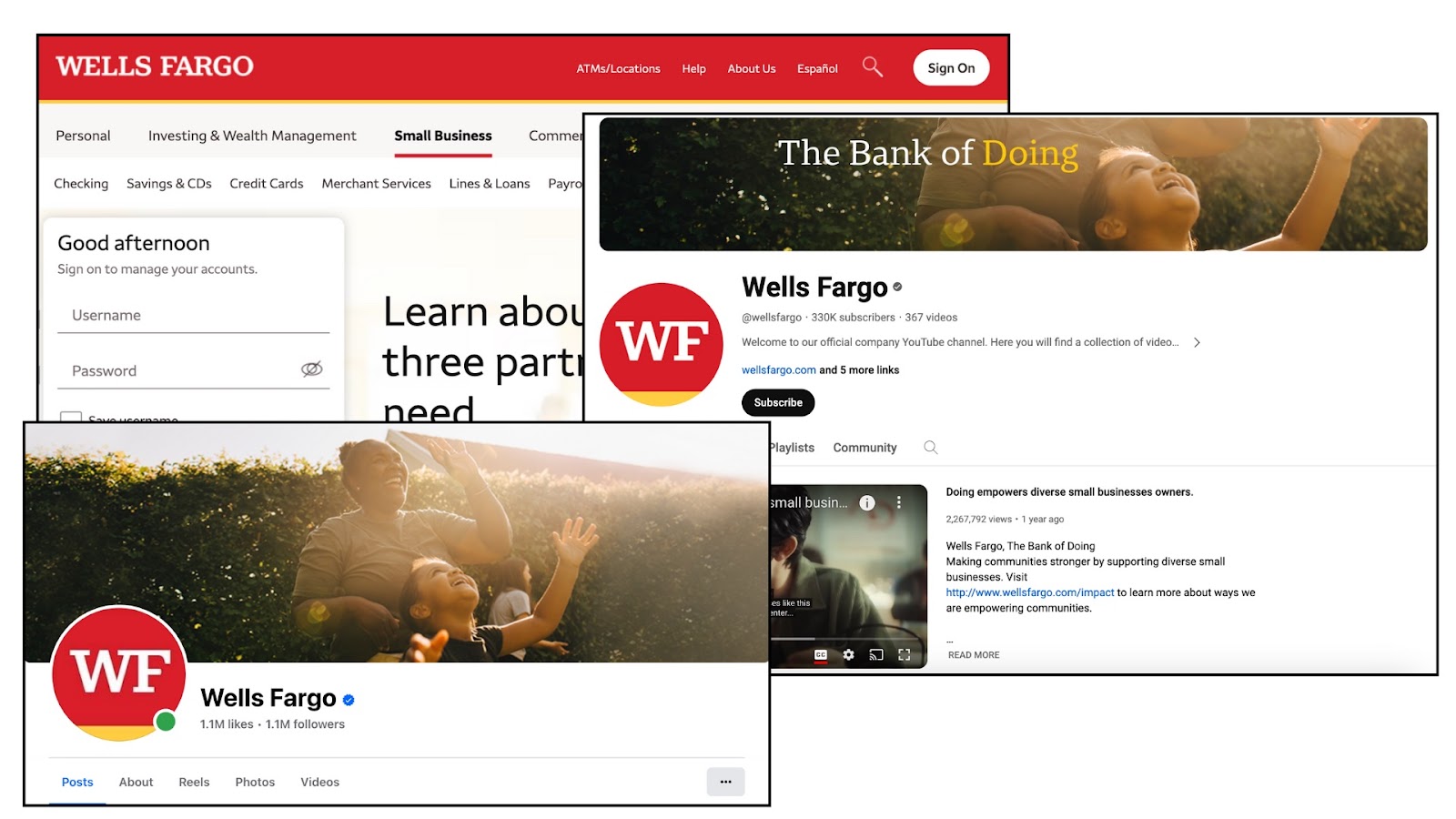
The bank uses the same layout, colors, and fonts on all channels. Plus, it maintains a conversational tone, regardless of the platform.
Further reading: Brand Identity: What It Is and How to Create a Strong One
Leverage Influencer Marketing in the B2B Space
B2B influencer marketing involves partnering with successful entrepreneurs, investors, business owners, or industry experts. If done right, it can help you raise brand awareness, improve your reputation, and increase sales.
Ideally, reach out to influencers targeting a similar audience. If you run an accounting business, team up with financial experts, bank managers, or fintech companies.
You could ask them to share your content, mention your brand, or recommend your products to their followers.
Some influencers will charge a flat fee. Others may accept non-financial incentives, such as free access to a training program developed by your company.
According to Gartner, 65% of B2B buyers use YouTube to make purchase decisions. A staggering 60% use Facebook for this purpose, and 55% will turn to Instagram to learn more about the products or services they want to buy.
An industry expert with thousands of social media followers could put your brand in front of a new audience.
Prioritize Sustainability and Corporate Social Responsibility
Sustainability and corporate social responsibility (CSR) focus on how a company’s activities impact society and the environment.
For example, unethical practices like employee discrimination or falsifying environmental data can affect a brand’s image and deter potential clients.
In a 2022 survey by AMA New York, 24% of B2B buyers agreed that companies should do more for the environment. Another 23% showed concern for racial inequality, and 34% said they prefer suppliers who are considered good employers.
Overall, 72% of B2B buyers reported they are more likely to buy from companies with strong social practices. And 35% said they would be willing to pay up to 10% more for products from purpose-driven suppliers.
This means that a strong commitment to sustainability and CSR may increase sales and open new doors.
Take Microsoft, for example. The company has been supporting the LGBTQIA+ community for over three decades.
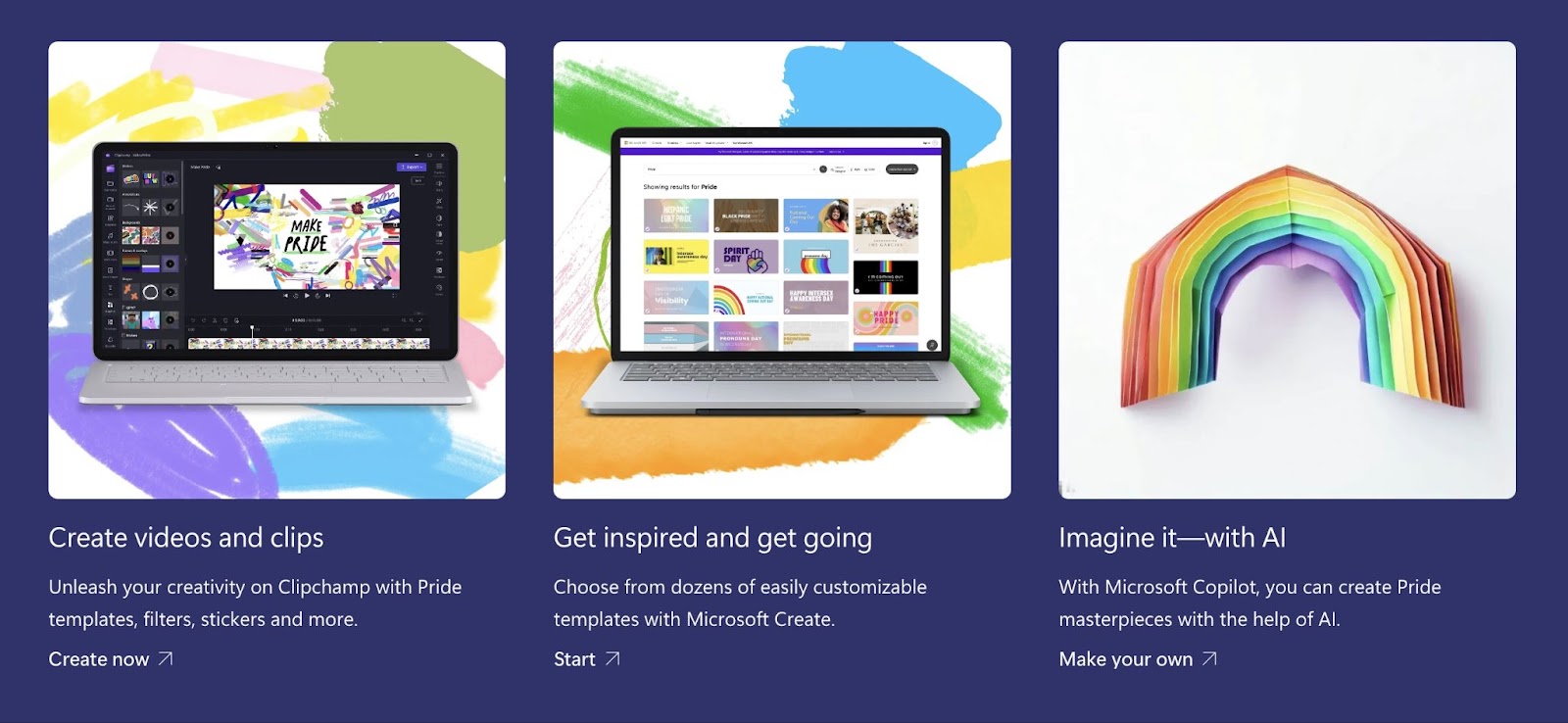
Not only does Microsoft employ LGBTQIA+ talent, it also sponsors events dedicated to the community. It launched a series of products, desktop wallpapers, and business tools to promote LGBTQIA+ equality.
Consider switching to more sustainable materials or ingredients to manufacture your products. Treat your employees fairly, regardless of age, race, or sexual orientation, and implement a DEI (Diversity, Equity, and Inclusion) policy.
Future-Proof Your B2B Marketing Strategy
These digital B2B marketing tactics apply to various industries, from fintech and software development to PR. But as technology evolves, we may witness the rise of new trends that will shape the marketing industry.
An example is the growing use of voice search, artificial intelligence, and augmented reality. Such technologies will allow for greater personalization, raising the bar for marketing and sales teams.
Semrush can help you stay at the forefront of innovation. Our tools evolve with the latest trends, harnessing data to drive business growth.
Use our Social Media Toolkit to plan, manage, and improve your social media advertising campaigns. Gather insights from your competitors with our Traffic Analytics tool and optimize your copy with the Keyword Magic Tool.
Go one step further and create engaging videos with the AI Video Marketing Automator. Turn your blog posts and articles into video content in minutes.
Ready to get started? Sign up for a Semrush account to use the latest tools to future-proof your B2B marketing strategy.

